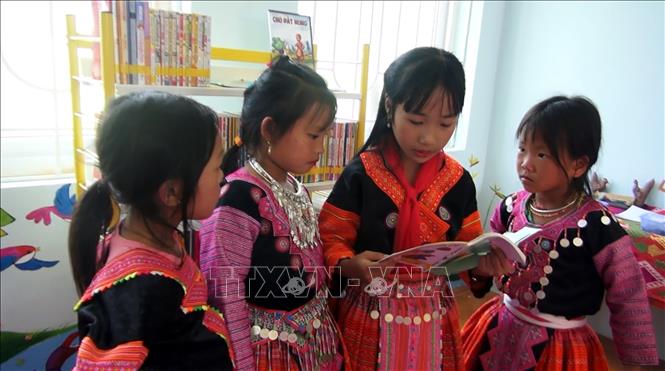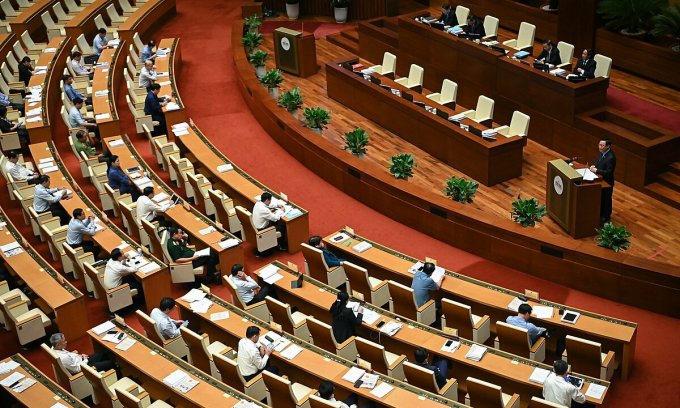Current status of education for ethnic minority in Vietnam

The basic objective of Vietnam’s development policy is to ensure access to education. Vietnamese law stipulates that the State gives priority to the development of education in mountainous areas, islands, ethnic minority areas and areas with extremely difficult socio-economic conditions in general and children in particular. However, there are still challenges and limitations in educating children in ethnic minority areas. The following article by LSX will shed light on “Current status of education for ethnic minority in Vietnam”. We invite you to follow and read right away!
Legal grounds
- Resolution No. 29-NQ/TW
Initial achievements in educational development in ethnic minority areas today
Thanks to the right and appropriate guidelines and policies of the Party and State, up to now, there have been many schoolmodels for children of ethnic minorities, such as: Ethnic Youth School, School of Study and Work. , boarding and semi-boarding high schools for ethnic minorities, university preparatory schools for ethnic minorities, cadet schools… The education system from preschool to high school has been consolidated and developed, initially meeting learning needs of children of ethnic minorities.
According to the survey results on the socio-economic situation of 53 ethnic minorities by the General Statistics Office and the Committee for Ethnic Minority Affairs, as of August 1, 2015: the number of ethnic minorities aged 15 years and older. able to read and write is 7,465,062 people (reaching 79.8%); the number of ethnic minority people aged 15 and over who can read and write in general is 7,416,732 people (reaching 79.2%); the percentage of employed people aged 15 and over who have received training, reaching 6.2%; the rate of students of school age, attending school at the right level reached 70.2%; the total number of schools in communes in ethnic minority areas is 17,722. According to statistics of the Ministry of Education and Training, in the 2014-2015 school year, the whole country had 304 ethnic minority boarding schools with nearly 64,697 students from 45/53 ethnic minorities, of which 215 were enrolled. district schools, 89 provincial schools. In the 2014 – 2015 school year, the number of primary school students who are ethnic children is 1,316,048; lower secondary school is 816,995 children; high school has 296,868 students.
Along with the development of the general education system, up to now, there have been 4 regional university centers: Northwest, Northeast, Central Highlands and Southwest. The system of vocational training schools and colleges has been consolidated and developed. Currently, nationwide, there are over 13,000 ethnic minority people with university, university or college degrees; more than 78 thousand people have professional secondary education,… have basically done the cause of illiteracy eradication and universalization of primary and lower secondary education; the scale of university, college, professional secondary school and vocational training continues to increase at a high rate; the skill level, technical expertise of labor is gradually raised; The potential and level of science – technology has made significant progress. The system of university preparatory schools and ethnic preparatory faculties is being developed both in terms of training scale and facilities. Ethnic language teaching programs for ethnic minority students were initially interested. The Ministry of Education and Training has compiled a number of textbooks teaching Khmer, Mong, Mnong, Bana, Ede, Cham, and Chinese scripts. nominate ethnic minority students to attend universities, colleges, and professional secondary schools, and many ethnic minorities are recruited to attend secondary schools, colleges and universities for the first time.
Current status of education for ethnic minority in Vietnam
In response to the development requirements of the country in the context of regional and international integration, and at the same time, in order to implement the policy of “Equality, solidarity, respect, mutual help for mutual development among nations”, remove gradually the gap in education between “upstream and lowland” requires further attention and investment in education in ethnic minority areas. The reality of poverty, underdevelopment, lack of awareness and understanding of the guidelines and policies of the Party and State; listening to bad guys to deceive and destabilize political security in some ethnic minority areas today is mainly due to the limited educational level of the people, especially in remote and isolated areas. borders and islands. The qualifications of the contingent of leaders and managers in ethnic minority areas are still limited and have not met the socio-economic development requirements of the localities. The percentage of cadres who are ethnic minorities in provincial and district agencies is still low (about 11.32%). Out of a total of 48,200 commune-level ethnic minority officials, 45.7% have lower secondary education, 18.7% primary school, and only 1.9% have college and university degrees. learn. The cadres of villages, hamlets, phum and squirrels have much lower capacity and qualifications. In addition, the trained labor force of ethnic minorities only reached 10.5%. Human resources in ethnic minority areas with university and post-graduate degrees only reached 2.8%, only ethnic minorities accounted for about 1.1%, 4 times lower than the whole country.
In general, the level of education and educational attainment of the ethnic minorities still has a significant gap with the majority. The quality of human resources of ethnic minorities is still limited, the number of ethnic minority cadres is lacking in number and a weak part in terms of professional qualifications. In the area of ethnic minorities compared to the national average, the gap between rich and poor among regions and between ethnic groups is still high and at risk of widening, reflected in the literacy rate of ethnic children. The rate of ethnic minorities is only 78% compared to the general literacy rate, the poverty rate of ethnic minority households is over 30% (currently there are more than 2,000 communes and over 18,000 villages with special difficulties). The rate of illiteracy and re-illiteracy among the people is still quite high, the percentage of people with a high level of education is very low (Brau is an ethnic group that has not yet attended university).
In order for all people to have a higher level of education, it requires more attention from the State by opening schools, classes, training teachers, etc. In areas with favorable terrain, such as the plains provinces. The midland is densely populated, the opening of schools is convenient, and the education sector is more interested, so the education level of the people is improved. On the contrary, in mountainous areas where ethnic minorities live, where the terrain is complicated and unfavorable, facilities and schools are lacking, so the work of developing education and improving the quality of life is very difficult. The education level of the people is still limited. Therefore, the educational level of the ethnic minorities is lower than the educational level of the majority ethnic people; or the education level of ethnic minorities living in remote, isolated and border areas is lower than that of ethnic minorities living in favorable areas.
The process of implementing educational development policies in ethnic minority areas has many shortcomings, from textbook programs, educational and teaching methods to policies towards teachers and educational administrators. The teaching staff is often lacking and weak, the policy on the use and treatment of teachers in ethnic minority areas is still unreasonable. attract teachers who are enthusiastic about the profession, with the development of educational career.
One of the factors limiting the development of education in many ethnic minority areas that the education sector has not paid adequate attention to is the problem of language differences in the teaching and learning process. Children who are not yet fluent in their mother tongue must learn Mandarin. Because they do not understand, study poorly, lose to friends, cause depression, fear of learning, and fear of going to school, many students have dropped out, leading to illiteracy and re-illiteracy.
For ethnic minorities, the question: what to study for is an issue that is directly related to the decision of families to send their children to school or not. Only when the people see the benefits of studying will they have the determination to send their children to school. Therefore, vocational training for students graduating from junior high and high schools is a core issue for the development of education in ethnic minority areas today. For many years, the Party and State have given priority policies to children of ethnic minorities in the cause of education. But if we don’t have synchronous solutions, it will be difficult for education in ethnic minority areas to meet the requirements in the period of accelerating industrialization and modernization of the country.
Some solutions to develop education in ethnic minority areas today
We cannot wait for economic development to develop education. Education must be one step ahead, we have experienced in developing the cause of education in the early days of independence, when the famine killed millions of people, but by doing well in campaigning and propagating the movement. popular education” has aroused our people’s tradition of studiousness. Developing education and training for ethnic minorities so that they have conditions to rise up and integrate with compatriots nationwide and exercise their equal rights in politics, economy, culture and society is a problem. very important and necessary. Therefore, it is necessary to have a scientific solution and consider it an urgent task. To promote the cause of education in ethnic minority areas today, all levels and sectors need to pay attention to the following issues:
Firstly, it is to increase investment in education development in border, remote, and ethnic minority areas with a small population. There must be a synchronous coordination between the policies of the Party and the State with the activities of the education sector and the contribution of the whole people to the cause of education in ethnic minority areas. Therefore, the socialization of education so that the whole people can pay attention and contribute in a practical way is one of the very necessary measures in the current period.
Secondly, it is necessary to train ethnic minority teachers with qualifications in both pedagogy and knowledge for each region and each ethnic group. In addition to training, it is necessary to develop a remuneration system and employ a contingent of teachers and educational administrators, so that they can feel secure in their careers and stick with the career of “growing people” in their own homeland. their.
Thirdly, the education sector must develop curricula, textbooks and teaching methods suitable to the target audience of each ethnic group and each region on the basis of 2 languages (mother tongue and common language). .
Finally, to have specific policies for children of ethnic minorities after graduating from high school, if they cannot take the exam to enter intermediate schools, colleges and universities, they will arrange for them to go to vocational schools and study abroad to decide on jobs and jobs after graduation to avoid wasting money and efforts of students, their families and human resources for the development of ethnic regions in the period of extensive international integration in the country.
Services of LSX
Prestigious professional services: Firstly, the team of consultants and consultants for many years in the field of civil status, and customer support.
On-time: Certainly, with the motto “Get your lawyer right at your fingertips”, we ensure the service always performs on time. The rights and interests of customers always come first.
Cost: Besides, LSX’s service costs are highly competitive; depending on the nature of the particular case. So, we want our guests to have the best possible service experience. Therefore, costs which guaranteed to be the most suitable and economical for customers.
Confidentiality of client information: Finally, all brand information of client LSX will be 100% confidential.
Please contact us immediately if you have any questions about “Current status of education for ethnic minority in Vietnam”
Contact LSX
Finally, hope this article is useful for you to answer the question about “Current status of education for ethnic minority in Vietnam” If you need any further information, please contact LSX Law firm: at +84846175333 or Email: [email protected]
Please see more
- What documents do Vietnamese children under 14 years old need to travel by plane?
- Records of children to be adopted under Vietnamese law
- After a divorce, until when do parents have to support their children
Frequently asked questions
Educational institutions, education and training departments, labor – invalids and social affairs departments.
– For preschool children, pupils and students studying at public educational institutions: The time limit for issuing a decision is 04 working days from the deadline for receiving applications.
– For preschool children, pupils and students studying at non-public educational institutions: The time limit for making a decision is 16 working days from the date of opening of the school year.
The economy is slow to develop, the per capita income is low, the poverty rate is high, people’s awareness is still limited, and the ability to integrate and apply science and technology to production has not been effective. In addition, due to the small population, limited scientific knowledge, most of them are relatives of the same village, so it also creates child marriage and inbreeding marriage, leading to many students with disabilities, cognitive slow… has had a significant impact on improving the quality of human resources of ethnic minorities.
Conclusion: So the above is Current status of education for ethnic minority in Vietnam. Hopefully with this article can help you in life, please always follow and read our good articles on the website: lsxlawfirm.com




